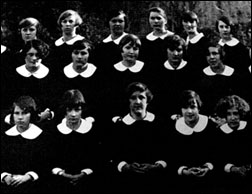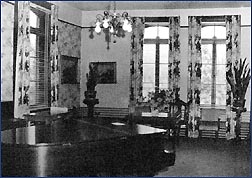
| KIDS | ||||
| Fun Stuff | ||||
|
||||
| Art Work | ||||
|
||||
| Create A Website | ||||
|
|
The objectives of the school were “to impart to young ladies the benefit of a good moral and domestic education, accompanied with the knowledge of the various branches of elementary training, together with those which constitute the higher departments of a finished education.” This was a reason for many to choose St. Ann’s Academy for their children. One student recalls her mother’s decision to send her to St. Anns (from the diary of Mary Anne Frances Shepard (1848 - 1913)): “I was now 16 years of age and had never attended school, except the little kindergarten at Fort (Hennes), so mother decided to send me away to some boarding school. At the Methodist Academy, in Salem, Oregon, she thought too much liberty was given the pupils, so after careful investigation she decided upon St. Ann’s Convent in Victoria”.
A strict daily schedule was to be followed by the girls. “...we had to rise at five-thirty in the morning; fifteen minutes to dress and shake up our beds (feathers) and be down to Chapel” ( From the diary of Mary Anne Frances Shepard (1848 - 1913)). In addition to this, there was prayer time and study time, and lights out at approximately 9:00pm. Students wore uniforms which, over the years, changed from skirts and blouses to dresses to tunics. The students were carefully monitored at all times. Still, they managed to have many good times. “While in the convent many amusing incidents occured - we were seldom alone, nearly always a teacher with us...” (Mary Anne Shepard). When the teachers weren’t around, students' mischief was soon on the loose. “Personal vanity was not encouraged in the convent; the only mirror being enclosed in the panels of a piano in the music room. There were four or five instruments in this room, and when we girls were in there practising, if the sister left us alone for a moment, a grand scramble was made for a peep at ourselves. We were sometimes caught at this, but the Sister never made any remarks. She probably knew that what couldn’t be cured must be endured”.
Things were kept interesting with the occasional squabble as well. “My last year in the convent was in 1865 and it was this year that I had my first and last fight...Sister Superior said she had news to read to us, and then proceeded to read of the assassination of President Lincoln...as soon as Sister Providence finished reading, one of the girls my own age shouted ‘Goody, goody’. In an instant I was at her, one hand in her hair; with the other I slapped her face. The sisters finally separated us, with the remark, ‘you must not fight’, and then turning to me she added ‘I do not blame you’”. Sometimes disagreements and breaking the rules resulted in punishment. “Eight or ten of us girls were once punished for some wrong doing, and were made to kneel upon the floor. Soon after, Father Saghers came into the room, making the pleasant remark that we were at our prayers. Returning soon after, he had a back view of us and read from a slip of paper pinned upon us the word ‘disobedient’. How he did laugh and weren’t we ashamed!” With all the laughter and tears, many close friendships were formed, and many stayed in touch after they left the school. One student, Louisa or Dolly Helmcken, received a special gift from her classmates for her birthday. It was an autograph book, filled with poems written by her classmate and cutout flowers. Dolly was the youngest daughter of Cecilia and John Helmcken. Her family was very well known, and today you can visit the Helmcken house to learn more about this family and to see some of her work. click here to visit Helmcken House Click here for more on Student Life
Contact
St. Anns Academy at stanns.academy@gems2.gov.bc.ca
Contact the Webmaster at zeroone@zeroonedesign.com
|
|||||

